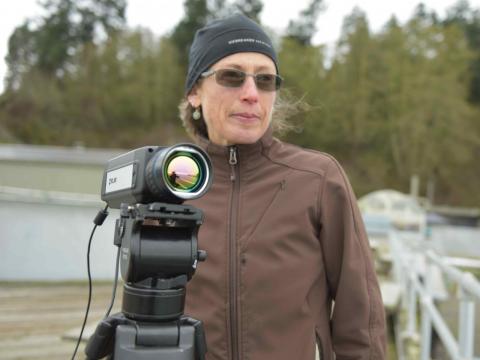PNNL Scientists Working to Harness Wind for Clean Energy

PNNL researchers led the upgrade of two research buoys that will collect data related to offshore wind and its energy-producing potential, shown here being readied by contractors for deployment off the east coast and planned for deployment off the coast of California this month.
Anyone who lives in the Tri-Cities knows about wind—or at least, we think we do.
But at the U.S. Department of Energy's Pacific Northwest National Laboratory (PNNL) we have experts who study the wind and use that knowledge to develop technology to harness it for clean and sustainable energy production.
Back in the 1980s, before any wind turbines dotted the Columbia Gorge skyline, PNNL researchers created a national wind energy atlas to assess the economic feasibility of wind power.
Today, they take a multidisciplinary approach to understanding both land-based and offshore wind energy resources and their potential impact on wildlife and the environment.
PNNL scientists draw upon their expertise in atmospheric science to study wind energy in support of DOE's Wind Energy Technologies Office. They combine theory, computer simulations and a diverse suite of meteorological observing systems to improve the accuracy and predictive power of their models.
Energy operators need a deep understanding of where, how and when the wind will blow as they determine where to locate a wind farm. This knowledge also allows them to operate the wind farm optimally in dynamically priced energy markets.

A few years ago, our researchers were part of a project to improve wind forecasts, focusing on the complex terrain of the Columbia Basin's hills and valleys.
They generated a comprehensive data set that led to more accurate computer algorithms that are now part of the National Weather Service forecast models.
Another project in the Midwest is looking to more accurately represent the way wind flows into and through the multiple turbines within a wind farm. For example, researchers are trying to capture how wind conditions for some turbines may be affected by others nearby, such as decreasing wind speeds for turbines in the "wake" of others.
PNNL researchers also are helping determine the energy-producing potential of offshore wind by gathering and analyzing wind measurements at turbine-blade height.
This month, two buoys that include major upgrades led by PNNL wind researchers are being deployed off the coast of California to support offshore wind development.
The buoys use lidar to gather data 200 meters above the surface. They are equipped with numerous atmospheric and oceanographic measurement capabilities that, together, capture data about wind speed and direction, the velocity of ocean currents, and the height and direction of ocean waves.

The data will be used to validate wind models, help improve understanding of what happens where the air and sea interact, and reduce the uncertainty in characterizing offshore wind resources.
Not only do PNNL researchers use these data in their own studies, our data management experts and computer scientists manage a data archive and web portal that make the data available to the public and industry.
Beyond collecting measurements specifically about the wind, PNNL researchers also develop technologies to monitor the environmental effects of wind turbines that can inform developers' decisions about where to locate them.
One such technology is ThermalTracker; a system that will be installed on one of the buoys in the spring to gather data about birds and bats, including their flight height, speed and passage rates.

The PNNL-developed software uses thermal cameras and stereo-vision processing to provide three-dimensional flight data to understand how wildlife behavior is affected by wind turbines.
It will provide daily updates on the number of birds in the area and whether they are flying at heights that put them at risk from a turbine.
For those of you familiar with this community's history, you may have heard about the terrible dust storms and "termination winds" of the 1940s that drove away some of the early Hanford workers and their families.
Today, the researchers at PNNL are learning how to harness these winds to secure a brighter, cleaner energy future for all of us.
Related videos
Steven Ashby, director of Pacific Northwest National Laboratory, writes this column monthly. To read previous Director's Columns, visit pnnl.gov/news and "filter by" Director's Columns in our Latest Stories.
Published: September 21, 2020